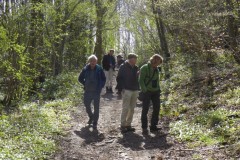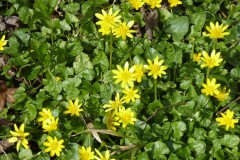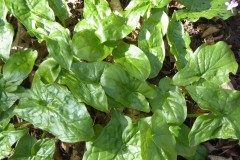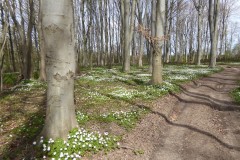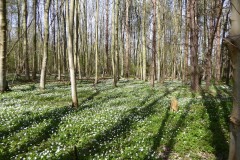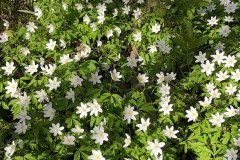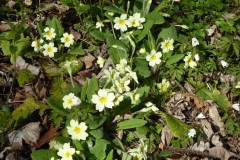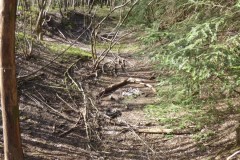Melton Wood survives as a colourful island of buzzing, babbling, interacting nature,
adrift in an ocean of arable crops made necessary by our clamouring hoards.
Assembled in the car park 10:30am.
After discussing the failures and … well … more failures of observing the convergence of Jupiter and Venus near the eastern horizon at 5am that morning, we were cautioned about the prevalence of dog dirt in the vicinity of the car park, the tripping hazards of tree stumps, fallen branches and bramble briars on the networks of woodland paths, and were advised to examine, sketch or photograph the notice board showing the map of the woodland rides so as to navigate our way back to the cars. The hearty group was then introduced to our guest (who had walked to the venue from Sprotborough) David Carroll, author of the book on the natural history of Melton Wood, which he reminded us, had been published by the DDOS exactly 40 years ago! (see references).
The group proceeded via the winding paths along the wood’s eastern perimeter, visiting the small, now overgrown, limestone quarry (not on the OS map) and proceeded to the northern portal of the main north/south ‘green lane’. Here we stopped for lunch and looked out over the arable monoculture due north towards the village of Marr, to the northeast to the wooded artificial uplands of the newly landscaped Brodsworth colliery tip (now re-branded Brodsworth Community Woodland) and due east to the chaos of traffic on the A1(M). Then looking to the west we could see at close quarters the array of wind turbines and distant views of the hedges and treescapes in the vicinity of Hickleton Park. Looking north towards Brodsworth Park, the now extensive arable landscape between Marr and Hickleton, appears on the 1st edition OS map as a huge area of deciduous woodland known as ‘Marr Thick’ … sadly now all gone.
After lunch we proceeded south along the length of the ‘green lane’, encountering the fascinatingly incongruous (on the limestone) peaty marsh and Rhododendron area. Some of us ventured west to list species in the 1km square SE5003, then on to the southern portal of ‘green lane’ with its gloomy grove of about 50 venerable Yews, the origins of countless sapling yews throughout the wood. The portal looked south out over yet more arable and to the tower of Melton Church and the roofs and tree tops of High Melton village.
The day had been a joy of carpets of colour, of yellow (of Lesser Celandine), white and pink (of Wood Anenome) and blue (of Bluebells), and a lofty architecture of mature tree trunks of Ash, Beech and Sycamore, Poplar, Pine and Yew.
Returned to car park 2:45pm
References
Carroll, D. (1980) Melton Wood pp. 1-2. In Limbert, M. (ed) Ornithological Sites around Doncaster.
Lapwing Special Series No. 1. Doncaster and District Ornithological Society.
Carroll, D. (1982) Melton Wood. Lapwing Special Series No. 2. Doncaster and District Ornithological Society.
| Botanical Names | Vernacular Names | SE5003 | SE5103 | SE5104 | SE5004 |
|---|---|---|---|---|---|
| Acer campestre | Field Maple | * | * | ||
| Acer pseudoplatanus | Sycamore | * | * | ||
| Aegopodium podagraria | Ground Elder | * | |||
| Aesculus hippocastanum | Horse Chestnut | * | |||
| Ajuga reptans | Bugle | * | * | * | |
| Alliaria petiolata | Garlic Mustard (Jack-by-the-Hedge) | * | |||
| Allium ursinum | Ramsons (Wild Garlic) | * | * | ||
| Anemone nemorosa | Wood Anemone | * | |||
| Angelica sylvestris | Angelica | * | |||
| Athyrium filix-femina | Lady Fern | * | |||
| Anthriscus sylvestris | Cow Parsley | * | * | ||
| Arctium minus | Lesser Burdock | * | * | ||
| Arum maculatum | Cuckoo Pint (Wild Arum) | * | * | ||
| Asplenium scolopendrium | Hart’s-tongue Fern | * | |||
| Brachypodium sylvaticum | Wood False-brome | * | * | ||
| Bryonia alba | White Bryony | * | |||
| Campanula latifolia | Giant Bellflower | * | |||
| Campanula trachelium | Nettle-leaved Bellflower | * | |||
| Carex flacca | Glaucus Sedge | * | |||
| Carex sylvatica | Wood Sedge | * | * | ||
| Cardamine flexuosa | Wavy Bittercress | * | |||
| Castanea sativa | Sweet Chestnut | * | |||
| Chamaenerion angustifolium | Rosebay | * | * | ||
| Circaea lutetiana | Enchanter’s Nightshade | * | * | ||
| Cirsium arvense | Creeping Thistel | * | * | ||
| Cirsium palustris | Marsh Thistle | * | |||
| Conopodium majus | Pignut | * | |||
| Cornus sanguinea | Dogwood | * | * | ||
| Corylus avellana | Hazel | * | * | ||
| Crataegus monogyna | Hawthorn | * | * | ||
| Dactylis glomerata | Cock’s-foot Grass | * | * | ||
| Deschampsia caespitosa | Tufted Hair-grass | * | |||
| Dryopteris filix-mas | Male Fern | * | |||
| Fagus sylvatica | Beech | * | * | ||
| Filipendula ulmaria | Meadowsweet | * | |||
| Fraxinus excelsior | Ash | * | * | ||
| Gallium aparine | Cleavers (Goosegrass) | * | * | ||
| Geum urbanum | Wood Avens (Herb Bennet) | * | * | ||
| Glechoma hederacea | Ivy, Ground | * | |||
| Heracleum sphondylium | Hogweed | * | * | ||
| Hyacinthoides non-scriptus | English Bluebell | * | * | ||
| Hypericum hirsutum | Hairy St John’s-wort | * | * | ||
| Hypericum tetrapterum | Square-stalked St John’s-wort | * | |||
| Ilex aquifolium | Holly | * | * | ||
| Juncus effuses | Soft Rush | * | |||
| Lamiastrum galeobdolon | Yellow Archangel | * | * | ||
| Lamium album | White Dead-nettle | * | |||
| Larix decidua | European Larch | * | * | ||
| Ligustrum vulgare | Wild Privet | * | * | ||
| Lolium perene | Rye-grass | * | |||
| Lonicera periclymenum | Honeysuckle | * | |||
| Mercuralis perennis | Dog’s Mercury | * | |||
| Milium efusum | Wood Millet | * | * | ||
| Moehringia trinervia | Three-nerved Sandwort | * | |||
| Oxalis acetosella | Wood Sorrel | * | |||
| Picea abes | Norway Spruce | * | |||
| Pinus nigra | Corsican Pine | * | * | ||
| Plantago lanceolata | Lanceolate Plantain | * | |||
| Plantago major | Broadleaved Plantain | * | |||
| Poa annua | Annual Meadow grass | * | * | ||
| Polypodium vulgare | Polypody | * | |||
| Populus sp | Avenue, possibly of Balsam poplars | * | |||
| Potentilla anserina | Silverweed | * | |||
| Potentilla reptans | Creeping Cinquefoil | * | |||
| Primula vulgaris | Primrose | * | |||
| Prunus avium | Wild Cherry | * | |||
| Prunus laurocerasus | Cherry Laurel | * | * | ||
| Pteridium aquilinum | Bracken | * | |||
| Quercus cerris | Turkey Oak | * | * | ||
| Quercus robur | Common Oak | * | * | ||
| Ranunculus ficaria | Lesser Celandine | * | * | ||
| Rhododendron ponticum | Rhododendron | * | * | ||
| Ribes rubrum | Red Currant | * | |||
| Rosa canina | Dog Rose | * | |||
| Rosa arvensis | Field Rose | * | |||
| Rubus fruticosus | Bramble | * | * | ||
| Rubus idaeus | Raspberry | * | |||
| Rumex crispus | Curl Dock | * | * | ||
| Rumex Obtusifolius | Broad Dock | * | * | ||
| Sambucus nigra | Elder | * | * | ||
| Sanicula europaea | Sanicle | * | |||
| Scrophularia nodosa | Common Figwort | * | |||
| Scrophularia auriculata | Water Figwort | * | |||
| Senecio jacobaea | Common Ragwort | * | * | ||
| Senecio vulgaris | Groundsel | * | |||
| Sorbus aucuparia | Rowan | * | * | ||
| Stachys sylvatica | Hedge Woundwort | * | * | ||
| Symphytum officinale | Comfrey | * | |||
| Symphoricarpos albus | Snowberry | * | * | ||
| Tamus communis | Black Bryony | * | |||
| Taraxacum officinalis | Dandelion | * | |||
| Taxus baccata | Yew | * | * | ||
| Tilia x europaea | Lime | * | |||
| Ulmus glabra | Wych Elm | * | |||
| Urtica dioica | Stinging Nettle | * | |||
| Veronica chamaedris | Germander Speedwell | * | |||
| Viburnum opulus | Guelder Rose | * | |||
| Viola riviniana | Common Dog-violet | * | * | ||
| Botanical Names | Vernacular Names | SE5003 | SE5103 |
|---|---|---|---|
| Aegithalos caudatus | Long-tailed Tit | * | * |
| Certhia familiaris | Tree Creeper | * | |
| Columba palumbus | Wood Pigeon | * | * |
| Cyanistes caeruleus | Blue Tit | * | |
| Dendrocopus major | Great Spotted Woodpecker | * | |
| Erithacus rubecula | Robin | * | * |
| Fringilla coelebs | Chaffinch | * | * |
| Garrulus glandarius | Jay | * | * |
| Parus major | Great Tit | * | * |
| Phylloscopus collybita | Chiffchaff | * | * |
| Phylloscopus trochilus | Willow Warbler | * | |
| Troglodytes troglodytes | Wren | * | * |
| Sitta europaea | Nuthatch | * | |
| Sylvia atricapilla | Blackcap | * | * |
| Turdus merula | Blackbird | * | * |
| Turdus philomelos | Song Thrush | * | * |
| Mistle Thrush | * | ||
| Botanical Names | Vernacular Names | SE5003 | SE5103 |
|---|---|---|---|
| Talpa europaea | Mole | * | * |
| Sciurus carolinensis | Grey Squirrel | * | * |
| Vulpes vulpes | Fox (scent) | * | * |
| Botanical Names | Vernacular Names | SE5003 | SE5103 |
|---|---|---|---|
| Aglais io | Peacock butterfly | * | |
| Andrena fulva | Tawny Mining Bee | * | |
| Anthocharis cardamines | Orange Tip | * | * |
| Bombus lapidarius | Red-tailed Bumblebee | * | * |
| Bombus lucorum | White-tailed Bumblebee | * | |
| Bombus terrestris | Buff-tailed Bumblebee | * | |
| Bombylius major | Dark-edged Bee-fly | * | |
| Gonepteryx rhamni | Brimstone | * | |
| Megachile sp | Leafcutter Bee (evidence of) | * | |
| Pararge aegeria | Speckled Wood | * | * |
| Pieris rapae | Small White | * | |
| Polygonia c-album | Comma | * | |
| Vespula vulgaris | Common Wasp | * | |
Doncaster Naturalists’ Society & Friends of Denaby Crags Preliminary visit to Denaby Crags, Good Friday 15 April 2022
The group met at the Crags Road entrance, split into two groups, one walking east to the Lady’s Valley quarry then west to the allotments, the other walking west along the crags then back to the allotments where both groups met for a very generous and enjoyable picnic lunch provided by the friends.
Although the Crags extend into at least three Ordnance Survey 1km squares, during this preliminary visit we mainly recorded in the 1km square SK5099. However, in future we need to name specific target sections of the Crags complex and record them separately.
| Botanical Name | Vernacular Name |
|---|---|
| Acer pseudoplatanus | Sycamore |
| Aesculus hippocastanum | Horse Chestnut |
| Ajuga reptans | Bugle |
| Alliaria petiolata | Jack-by-the-hedge |
| Alliaria petiolata | Garlic Mustard |
| Allium ursinum | Wild Garlic (Ramsons) |
| Allium oleraceum | Field Garlic Abundant beside path edges (SK 50367 99186) |
| Alnus glutinosa | Alder |
| Anemone nemorosa | Wood Anenome (in Flower) (SK49957 98914) |
| Angelica sylvestris | Wild Angelica |
| Anthriscus sylvestris | Cow Parsley |
| Arctium minus | Lesser Burdock |
| Artemisia vulgaris | Mugwort |
| Arum maculatum | Arum |
| Bellis perennis | Daisy (in flower) |
| Betula pendula | Silver Birch |
| Borago officinalis | Borage (Allotments) |
| Brachypodium sylvaticum | False Brome |
| Brachypodium pinnatum | Tor Grass |
| Cardamine flexuosa | Wavy Bittercress |
| Centaurea nigra | Common Knapweed |
| Centaurea scabiosa | Greater Knapweed |
| Chamaenerion angustifolium | Rosebay |
| Cirsium arvense | Creeping Thistle |
| Cirsium vulgare | Spear Thistle |
| Cornus sanguinea | Dogwood |
| Corylus avellana | Hazel |
| Cotoneaster horizontalis | Rockspray Cotoneaster (Cultivated plant disbursed in bird droppings) (SK 50305 99080) |
| Crataegus monogyna | Hawthorn |
| Cytisus scoparius | Broom (SK49995 98921) |
| Dactylis glomerata | Cock’s-foot |
| Epilobium hirsutum | Hairy Willowherb |
| Euonymus europaeus | Spindle |
| Euphorbia helioscopia | Sun Spurge |
| Fagus sylaticus | Beech |
| Ficaria verna | Lesser Celandine (in flower) (SK 50151 99014) |
| Filipendula ulmaria | Meadowsweet |
| Fraxinus excelsior | Ash |
| Galium aparine | Cleavers |
| Geranium robertianum | Herb Robert |
| Geum urbanum | Wood Avens |
| Glechoma hederacea | Ground Ivy (in flower) |
| Hedera helix | Ivy |
| Heracleum sphondylium | Hogweed |
| Hyacinthoides non-scripta | Bluebell (in flower) (SK50518 99318) |
| Hypericum hirsutum | Hairy St John’s-wort (SK50305 99076) |
| Ilex aquifolium | Holly |
| Lamium album | White Dead Nettle (in flower) |
| Lamium purpureum | Red Dead Nettle (in flower) |
| Lathyrus pratensis | Meadow Vetchling |
| Lonicera periclymenum | Honeysuckle |
| Luzula camestris | Field Woodrush [Good Friday Grass] (in flower) |
| Malus x domestica | Apple (in flower) |
| Mercurialis perennis | Dog’s Mercury (in flower) (SK50305 99076) |
| Narcissus pseudonarcissus | Cultivated Daffodil (in flower) |
| Oxalis articulata | Pink Sorrel (in flower) (Allotments) |
| Phalaris arundinacea ‘picta’ | Reed Canary Grass or Ribbon Grass [Varigated in allotments] |
| Plantago lanceolata | Ribwort Plantain |
| Plantago major | Broad-leaved Plantain |
| Populus sp. | Poplar sp. possibly Balsam Poplar |
| Potentilla reptans | Creeping Cinquefoil |
| Prunus avium | Wild Cherry (in flower) |
| Prunus spinosa | Blackthorn (in flower) |
| Pteridium aquilinum | Bracken |
| Quercus ilex | Holm Oak (SK50154 99010) (Introduced from the eastern Mediterranean in the 1500s) |
| Quercus petraea | Sessile Oak |
| Quercus robur | Pedunculate Oak |
| Ranunculus acris | Meadow Buttercup |
| Ranunculus auricomus | Wood Goldilocks (in flower) Abundant beside path edges (SK50428 99248) |
| Ranunculus repens | Creeping Buttercup |
| Reynoutria japonica | Japanese Knotweed [a notifiable pest!] (SK49909 99107) |
| Rosa canina | Dog Rose |
| Rubus fruticosus | Bramble |
| Rubus-idaeus | Raspberry |
| Rumex obtusifolius | Broad Dock |
| Salix caprea | Goat Willow (in flower) |
| Sambucus nigra | Elder |
| Senecio vulgaris | Groundsel (in flower) |
| Sorbus aucuparia | Rowan |
| Stachis sylvatica | Hedge Woundwort |
| Stellaria holostea | Great Stitchwort (in flower) |
| Stellaria media | Common Chickweed (in flower) |
| Taraxacum officinale agg | Dandelion sp. |
| Taxus baccata | Yew |
| Teucreum scorodonia | Wood Sage |
| Tilia sp | Lime sp. |
| Tussilago farfara | Colt’s foot (in flower) (SK50393 99225) |
| Ulex europaeus | Gorse (SK50017 98937 & SK49995 98921) |
| Urtica dioica | Stinging Nettle |
| Veronica chamaedrys | Germander of Birds-eye Speedwell (in flower) |
| Veronica hederifolia | Ivy-leaved Speedwell (in flower) |
| Veronica persica | Field Speedwell (in flower) |
| Viburnum lantana | Wayfaring Tree (SK50327 99124 & SK50305 99076) |
| Viburnum opulus | Guelder Rose |
| Vicia sepium | Bush Vetch |
| Viola odorata | Sweet Violet (SK50305 99076) |
| Viola riviniana | |
| HYMENOPTERA (Bees & Wasps) | |
|---|---|
| Bombus lapidarius | Red-tailed Bumblebee (Queen) |
| Leaf Miners | |
| Diptera (Flies): Agromyzidae | |
| Phytomyza ilicis | Blotch mines on Holly leaves |
| HETEROPTERA (inc. SHIELDBUGS) | |
| Palomena prasina | Green Shieldbug: Sucks the sap of a range of wild and cultivated trees and shrubs |
| LEPIDOPTERA (Butterflies) | |
| Aglais urticae | Small Tortoisehell: 2 sightings. Caterpillars feed on the leaves of Stinging Nettles. |
| Anthocharis cardamines | Orange-tip: 6 sightings. Caterpillars feed on Cuckoo Flower or Lady’s Smock, which loves boggy areas, or in dryer areas like the Crags they lay their eggs on Hedge Garlic/Garlic Mustard. |
| Celastrina argiolus | Holly Blue: Caterpillars feed on the leaves of Holly (for the spring generation) and Ivy (for the summer generation), although other food plants include Spindle & Bramble. |
| Gonepteryx rhamni | Brimstone: 7 sightings. Caterpillars feed on the leaves of Buckthorn and Alder Buckthorn so one or both of these shrubs must grow somewhere in your area. Adults take nectar from purple/blue flowers, so bluebells are an important early spring nectar source. |
| Inachis io | Peacock: 2 sightings. Caterpillars feed on the leaves of Stinging Nettles. |
| Pararge aegeria | Speckled Wood: 3 sightings, including pair of males in territorial combat. Caterpillars feed on the leaves of False Brome, Cock’s-foot Grass; Yorkshire-fog & Common Couch Grass, all of which grow on the Crags. |
| Pieris napi | Green-veined White: Caterpillars feed on members of the cabbage family including Cuckooflower and Hedge mustard. |
| BIRDS | |
| Turdus merula | Blackbird |
| Sylvia atricapilla | Blackcap (singing) [summer migrant] |
| Chroicocephalus ridibundus | Blackheaded Gulls (flying over) |
| Corvus corone | Carrion Crow (flying over) |
| Fringilla coelebs. | Chaffinch (singing) |
| Phylloscopus collybita | Chiffchaff (singing) [summer migrant] |
| Columba livia domestica | Domestic (loft) Pigeons (flying over) |
| Parus major | Great Tit (calling) |
| Corvus monedula | Jackdaws (flying over) |
| Pica pica | Magpie |
| Erithacus rubecula | Robin (singing) |
| Turdus philomelos | Song Thrush (singing) |
| Columba palumbus | Wood Pigeons |
| Troglodytes troglodytes | Wren (singing) |
Prelude:
“… it is indeed a very attractive place to visit. In early spring the Wood Anenomies, Bluebells, Violets, Primroses and Cowslips are a pleasure to see whilst later, as the trees burst into leaf, Ramsons form a white covering on the ground interspersed with Yellow Archangel and Red Campion” (Dorothy Bramley 1993).
Aims: The aims of the excursion were to record in most of the 1km squares covered by the mosaic of woodland habitats of Wadworth Wood, enjoy the flush of spring flowers, estimate the number of Spurge Laurel clumps, attempt to locate the population of Lily of the Valley and record the dominant ground flora colonising the curious Sink Holes. The wood is recognised as a DMBC Local Wildlife Site, was surveyed by the Doncaster Nats in 1992 & 93, and was the subject of a Nats publication edited by Dorothy Bramley (Bramley, 1993).
A Catalogue of Errors
Two days before the advertised event I prospected the assembly point, the track to the venue and walked around the networks of paths and routes through the larger part of the wood as far as the M18 underpass and back. All seemed well for both natural history and health and safety.
Being in denial of the advertised 10am start time, I drifted through the morning expecting to emerge at 10.30. This was despite frantic, but unheard, phone calls and tappings on doors and windows by our reliable and dutiful president … so I apologise for my late arrival at the Short Lane venue.
All went well during the morning until we passed through the underpass to reach the sections of woodland to the north of the M18. Here, despite the absence of significant rain, the rides were like the Somme, churned and deeply rutted by trail and quad bikes. This required us to enter the woodland, attempting to make progress parallel to the paths. However, this brought us into direct and exhausting conflict with brambles, dangerously abundant dead wood and the debris of tree felling, all making scratching, stabbing, tripping and falling a likely outcome.
Being unable to use the defined paths also presented us with the problems of how to traverse the normally dry gullies running down to the series of ‘sink holes’ which we’d come to inspect and which to the south of the M18 had presented no problems. This day the gullies, which had been used as water hazards by the ‘off roaders’, were impassable leading to lengthy and strenuous detours, again though thick undergrowth with perils underfoot.
Although nobody actually died and after several confirmatory phone calls we had all got home, Nora and Louise had indeed suffered falls. Painful knees and hips were further inflamed by the strenuous and unremitting exercise and Louise who slipped and fell headlong into one of the flooded ruts had been covered in what potters would describe as ‘clay slip’.
In retrospect, as leader I should have prospected the entire woodland complex and abandoned the visit to the areas to the north of the motorway.
Key : *
Indicates 1km squares South of the M18 while + Indicates the 1km squares North of the M18
| Botanical Name | Vernacular Name | SK5596* | SK5597* | SK5696* | SK5597+ | SK5598+ | SK5698+ |
|---|---|---|---|---|---|---|---|
| Acer pseudoplatanus | Sycamore | * | * | * | |||
| Alliaria petiolata | Jack-by-the-hedge | * | * | * | * | * | * |
| Allium ursinum | Wild Garlic (Ramsons) | * | * | * | * | * | |
| Alnus glutinosa | Alder | * | * | ||||
| Anemone nemorosa | Wood Anenome (in Flower) | * | * | * | * | * | |
| Angelica sylvestris | Wild Angelica | * | * | * | |||
| Arctium minus | Lesser Burdock | * | |||||
| Arum maculatum | Arum | * | * | * | * | * | |
| Bellis perennis | Daisy (in flower) | ||||||
| Betula pendula | Silver Birch | * | * | * | * | ||
| Brachypodium sylvaticum | False Brome | * | * | * | * | ||
| Brassica napus | Rape | * | |||||
| Centaurea nigra | Common Knapweed | * | * | * | * | ||
| Cirsium arvense | Creeping Thistle | * | |||||
| Conopodium majus | Pignut | * | |||||
| Cornus sanguinea | Dogwood | * | * | * | |||
| Corylus avellana | Hazel | * | * | * | * | * | |
| Crataegus monogyna | Hawthorn | * | * | * | * | * | * |
| Dactylis glomerata | Cock’s-foot | * | * | * | * | * | * |
| Daphne laureola | Spurge Laurel (in flower & fruit) | * | |||||
| Deschampsia flexuosa | Wavy Hair-grass | * | * | * | |||
| Epilbium hirsutum | Hairy Willowherb | * | * | * | |||
| Euonymus europaeus | Spindle | * | * | * | * | ||
| Fagus sylaticus | Beech | * | * | ||||
| Ficaria verna | Lesser Celandine (in flower) | * | * | * | * | * | * |
| Filipendula ulmaria | Meadowsweet | * | * | * | * | ||
| Fraxinus excelsior | Ash | * | * | ||||
| Galium aparine | Cleavers | * | * | * | * | * | * |
| Geranium robertianum | Herb Robert | * | * | ||||
| Geum rivale | Water Avens | * | * | * | |||
| Glechoma hederacea | Ground Ivy (in flower) | * | * | * | * | * | * |
| Hedera helix | Ivy | * | * | * | * | * | |
| Heracleum sphondylium | Hogweed | * | * | * | |||
| Hyacinthoides non-scripta | Bluebell (in flower) | * | * | * | * | * | |
| Hypericum hirsutum | Hairy St John’s-wort | * | |||||
| Ilex aquifolium | Holly | * | * | * | * | ||
| Lamium album | White Dead Nettle (in flower) | * | * | * | * | * | |
| Lamium purpureum | Red Dead Nettle (in flower) | * | |||||
| Ligustrum vulgare | Wild Privet | * | * | * | * | * | |
| Lonicera periclymenum | Honeysuckle | * | * | * | * | * | |
| Lysimachia nemorum | Yellow Pimpernel | * | |||||
| Mercurialis perennis | Dog’s Mercury (in flower) | * | * | * | * | * | * |
| Narcissus pseudonarcissus | Cultivated Daffodil (in flower) | * | |||||
| Phyllitis scolopendrium | Hart’s–tongue Fern | * | * | ||||
| Pinus nigra | Corsican Pine | * | * | * | |||
| Pinus sylvestris | Scots Pine | * | * | * | |||
| Plantago lanceolata | Ribwort Plantain | * | * | * | * | ||
| Plantago major | Broad-leaved Plantain | * | * | * | |||
| Potentilla reptans | Creeping Cinquefoil | * | * | * | |||
| Primula veris | Cowslip (in flower) | * | * | * | |||
| Primula vulgaris | Primrose (in flower) | * | * | ||||
| Prunus avium | Wild Cherry (in flower) | * | * | * | |||
| Prunus spinosa | Blackthorn (in flower) | * | * | ||||
| Pteridium aquilinum | Bracken | * | * | * | * | ||
| Quercus robur | Pedunculate Oak | * | * | * | * | ||
| Ranunculus repens | Creeping Buttercup | * | * | * | * | ||
| Rosa campestris | Field Rose | * | * | ||||
| Rosa canina | Dog Rose | * | * | * | |||
| Rosa spinosissima | Burnet Rose | * | |||||
| Rubus caesius | Dewberry | * | |||||
| Rubus fruticosus | Bramble | * | * | * | * | * | * |
| Rumex obtusifolius | Broad Dock | * | * | * | * | * | * |
| Salix caprea | Goat Willow (in flower) | * | * | * | * | ||
| Sambucus nigra | Elder | * | * | * | * | * | |
| Senecio vulgaris | Groundsel | * | * | * | |||
| Stachis sylvatica | Hedge Woundwort | * | * | ||||
| Stellaria holostea | Great Stitchwort | * | * | * | * | ||
| Stellaria media | Common Chickweed (in flower) | * | * | ||||
| Taraxacum officinale agg | Dandelion sp. | * | * | * | * | * | |
| Taxus baccata | Yew | * | * | * | |||
| Sinapis arvensis | Charlock (in flower) | * | |||||
| Teucreum scorodonia | Wood Sage | * | * | ||||
| Tilia cordata | Small-leaved Lime | * | |||||
| Ulmus glabra | Wych Elm | * | * | ||||
| Urtica dioica | Stinging Nettle | * | * | * | * | * | * |
| Veronica beccabunga | Brooklime | * | |||||
| Veronica persica | Field Speedwell (in flower) | * | * | * | * | ||
| Viola richenbachiana | Early Dog Violet | * | |||||
| Viola riviniana | Common Dog Violet (in flower) | * | * | * | * | * | |
| SK5596* | SK5597* | SK5696* | HSK5597+ | SK5598+ | SK5698+ | ||
|---|---|---|---|---|---|---|---|
| FUNGI | |||||||
| Laetiporus sulphureus | Chicken of the woods [Old specimen on and below Yew] | * | |||||
| Fomitopsis betulinus | Birch Polypore | * | * | ||||
| SPIDERS | |||||||
| Pardosa nigriceps | Wolf Spider | * | * | * | * | ||
| DIPTERA | |||||||
| Bombylius major | Dark-edged Bee-fly (5 different spns. Nectaring on Viola riviniana & Glechoma hederacea) |
* | * | ||||
| HYMENOPTERA | |||||||
| Bombus lapidarius | Red-tailed Bumblebee (Queen) | * | * | * | * | * | * |
| Andrena fulva | Tawny Mining Bee (Visiting newly excavated hole in Permian marl path) | * | |||||
| LEAF MINERS | |||||||
| Lepidoptera: Nepticulidae | |||||||
| Stigmella aurella | Golden Pigmy. Leaf Miner on Bramble |
* | * | * | * | ||
| Stigmella splendidissimella | Glossy Bramble Pigmy. Leaf Miner on Bramble |
* | * | * | * | ||
| LEPIDOPTERA (Butterflies) | |||||||
| Small Tortoiseshell |
* | ||||||
| Peacock |
* | * |
